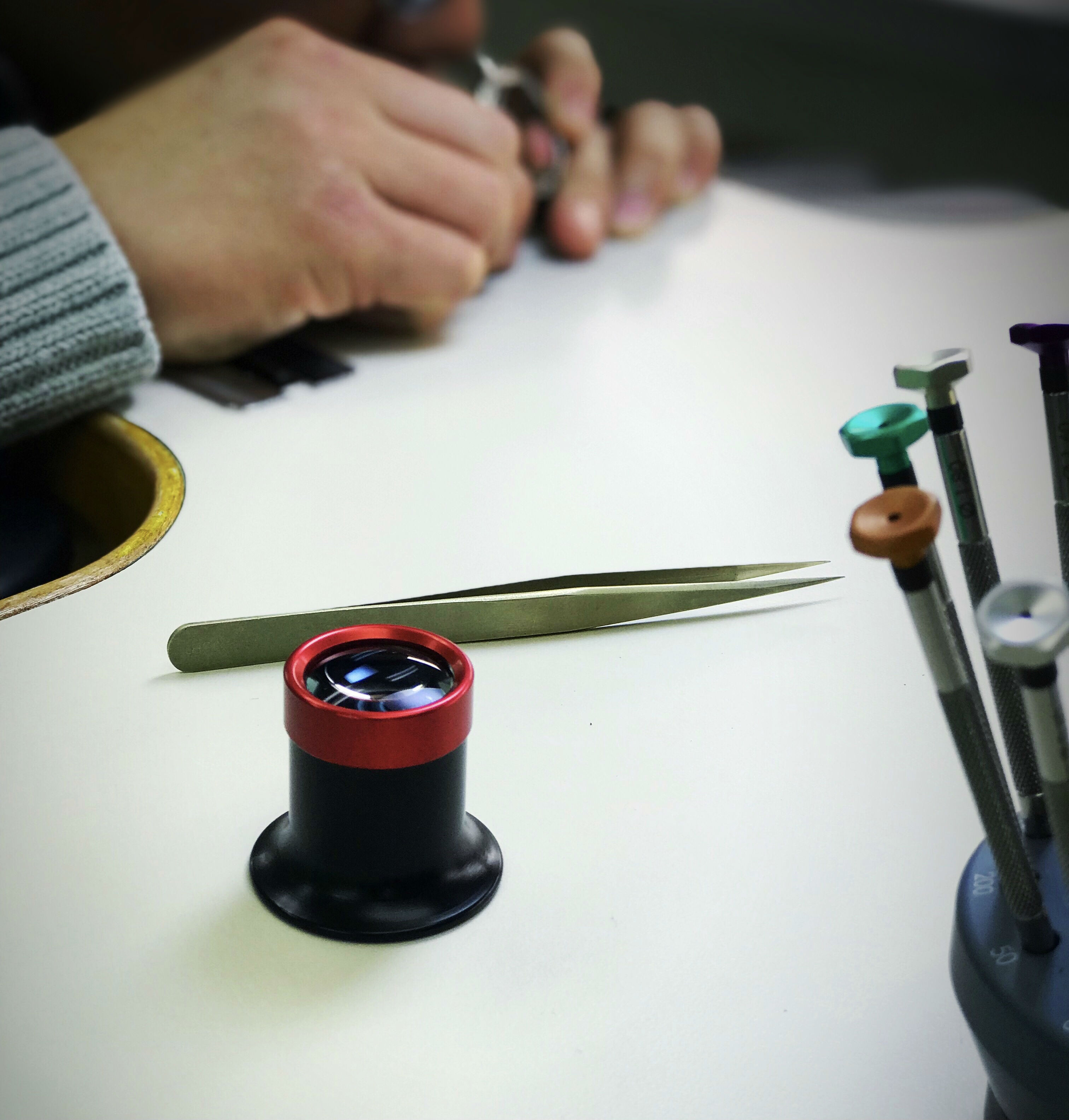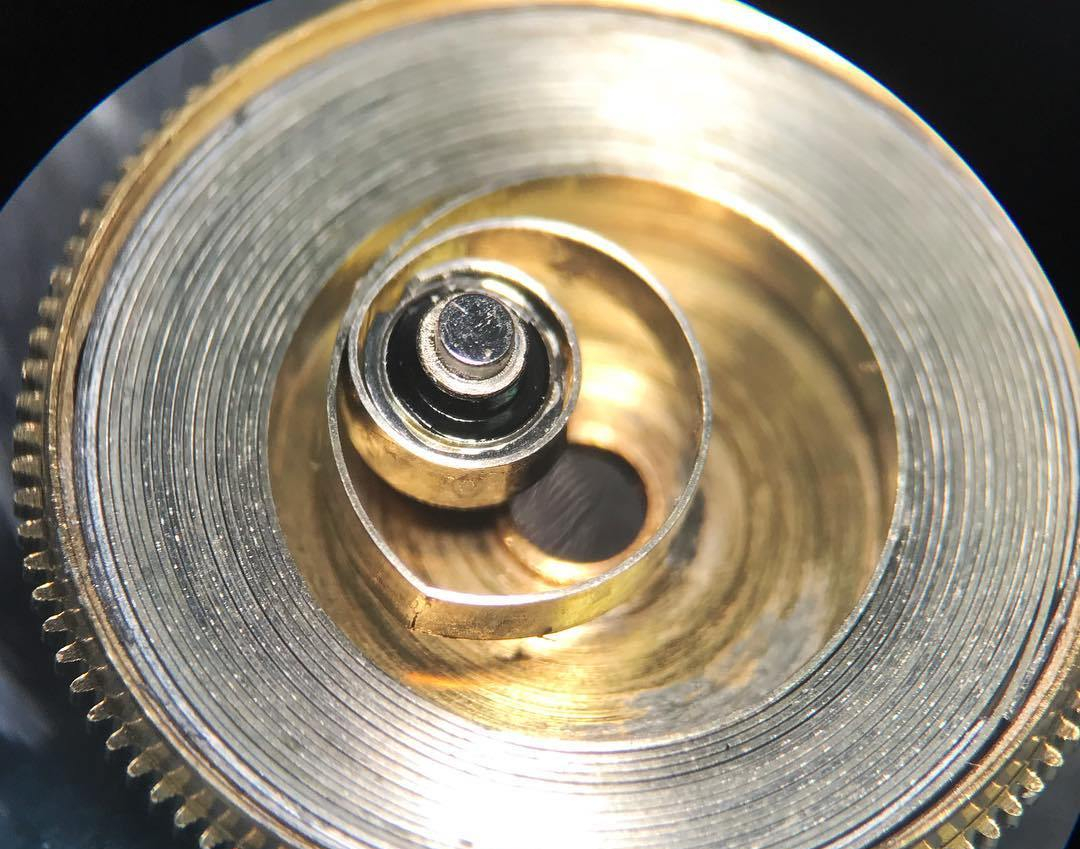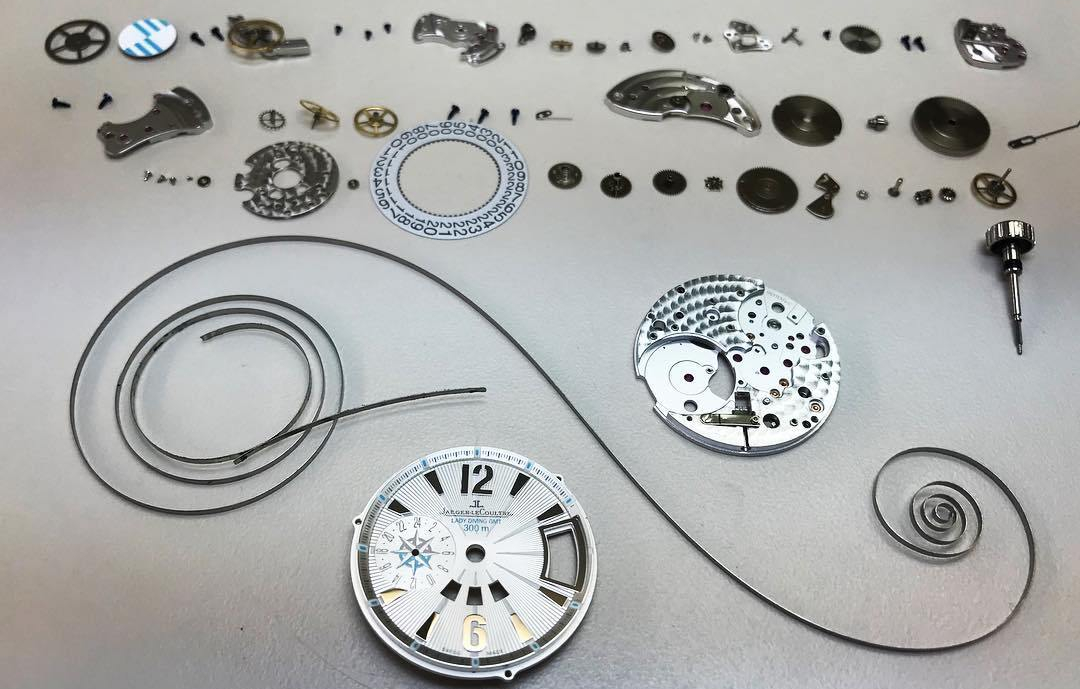Time for some no holds barred watch talk everybody. We’re talking with “No BS Watchmaker“.
As the name suggests, No BS Watchmaker (Anthony) keeps it real. He is a watchmaker, an author, teacher & also hosts a No BS Podcast. At the time of writing this, he is tied up with the launch of his new video course ‘The No BS Watchmaking Course’. Despite all those goings-on, he found the time to virtually sit down with us and have a Q&A. If you like watches and what makes them tick, do yourself a favor and at the very least follow him on your Social Media channel of choice. He offers exceptional insight in the world of watchmaking. You might learn a thing or two along the way as well.
Without further ado, let’s dive head first into the no BS world of watchmaking…

JAN:You must see a lot of watches that are hanging onto their last breath, hoping that you’ll keep their wheels spinning happily ever after. What is the most common cause of watches ending up on your workbench in a dire condition?
ANTHONY:Ah the common issues introduced by customers! It honestly depends on the season. For example, it’s not uncommon to find water damaged watches in the summertime months. On the flip side, during the winter months, it’s not uncommon to find impact related damages from falling and slipping on ice.
The most common causes of watches ending up on my bench can usually be traced back to 3 things: a too long of a lapse between service cycles, user negligence, and or uninformed customers.
Too long of a lapse between service cycles can wreak havoc in a watch. Oils dry up over time with or without you wearing the watch. If you haven’t had your mechanical watch serviced in 10+ years, don’t be surprised when your mainspringMainspring The mainspring is a spiral-shaped metal spring that stores energy in a mechanical watch movement. It is located inside the barrel. The mainspring is wound, either manually or automatically. The mainspring unwinds over time, and the watch will stop running when the mainspring is fully unwound. [Learn More] snaps in half one day.

User negligence or user introduced error is one of the common reasons that watches show up on my bench. They either don’t take care of their watches or they aren’t proactive enough. User negligence may be in the form of impact damage, water related damages, etc. A perfect example of user negligence would be unscrewing the crownCrown The knob on the outside of the watch that you typically use to either wind the mainspring or set the time [Learn More] to set the time and forgetting to screw it back down before you jump into the pool (true story by the way).
JAN:Nobody likes to send in his or her watch for service if it’s ticking along nicely. Let’s assume you have reached the recommended service period, should you immediately break into sweat and tears and send it out? Or if it ain’t broke, don’t fix it?
ANTHONY:
There’re two schools of thoughts here. None of them are right or wrong. Let me explain my stance on this from both views so that you guys as the readers can get a better grasp at this. No one likes to ever get their stuff serviced. It’s money. So it’s not uncommon for people to wait until their watches stop working to get it fixed as opposed to getting it serviced every 4-7 years. With modern watches, parts are easily available. The movements are relatively new and the level of quality is better than vintage watches. If there are any worn/used parts that need replacing, we can still get those parts to replace them today.
The only time problems ever present themselves here is if the watch is a vintage watch or if the movement is an in-house one. Think of it like this. Nowadays, almost everyone uses synthetic oils as watch lubricants. It’s wonderful and definitely way better than the oils of the past. One of the problem with synthetic oils is that, over a period of time, they evaporate. When synthetic oils evaporate, pivots and wheels run dry. This causes extra friction and shearing between the metals and rubies in the movement. You can kind of see where I’m going with this. Eventually dirt and debris will build up and wreak havoc in the watch. At this point, it’s not a matter of if but when parts will break. And you definitely don’t want broken parts in a vintage watch. Parts will be hard to find and costs of service will increase dramatically. It’s vintage for a reason.
So for vintage watches, I recommend getting them serviced when the service cycle is up. That is, if you’re actually wearing it daily. If it’s a modern watch, I’d say leave it until it breaks. My stance is going to differ for each individual and circumstances so keep in mind that this is a blanket statement.
JAN:
Other than respecting the service intervals, what do you consider ‘best practice’ in making sure a watch has a happy life?
ANTHONY:
I’m a huge proponent of living your life the way you want to live it. Hell, if you want to bungee jump, sky dive, etc. who has the right to stop you? But if you’re wearing a watch that’s designed to be a dress watch in an adventurous manner, you’re going to be in a world of trouble. I tell plenty of my customers that the key to prolonging a watch is moderation. If you own a Patek Philippe, maybe you shouldn’t wear it during a rock climb. If you own a Rolex, maybe you shouldn’t wear it when you’re doing construction. A well designed watch has it’s own category. Find out what category your watch is in and stick with that. Don’t wear your Patek Philippe to a marathon race. Perhaps a G-Shock would do. By wearing the watches the way they were designed and intended for, you’re ensuring the proper safety in terms of best practices. Moderation is king.
JAN:Watch brands today love to shout as loud as possible that they use in-house movements. It seems that not too long ago, nobody really cared that much. From your point of view, is in-house always better?
ANTHONY:
In-house watches are not always better. Here’s a different angle and perspective for you guys. Keep this in mind- it’s not a matter of if but when you need a service. With in-house movements, you’ll need to have it sent back to the manufacturer if there are any broken parts. Trust me when I tell you, they will have the monopoly over the price.
Compare that to a regular ETA movement where you can go price shopping amongst other repair shops. You have the freedom to go around and choose who you want. With in-house movements, you can’t. If you have a part broken in there and it needs to be replaced, in-house manufacturers will 95% of the time not sell them to independent repair shops. Thus, you have to go back to the original manufacturer to get it repaired. Mind you, you will not have the ability to negotiate or even price shop.
Another thing you should consider is- will the manufacturer be around 15, 30, and even 80 years later? What if they go out of business? What if they get bought out and the new owners decide to scrap up the very same in-house movement you have? What if you pass away and your watch gets passed down to the next generations, will they have access to get it repaired?
Of course, there is some sort of prestige amongst certain watch guys with in-house movements and in-house movements are honestly not all bad. It’s just very important to understand the logistics behind it though and think long-term about it prior to buying.
JAN:
In-house mechanical movements are all the rage nowadays, while Quartz is getting little to no love from watch enthusiasts. Do they deserve this almost instant dismissal by the watch community?
ANTHONY:
I don’t believe that quartz watches deserve an instant dismissal.
I think the hate for quartz is actually out of love for watchmaking. Look at it this way- most people look at quartz like a computer. We all know computers will come and go. Technology gets better by the day. We all hate having to upgrade. A computer I buy today can cost $1500 but may cost $600 months from now. Technology gets slow and outdated. We project this same idea and experience to quartz watches.
Quartz certainly have a place in watchmaking. Albeit it’s not as romantic as having a full mechanical watch independent of any electrical input. Certain fields and industries heavily rely on a watch to tell accurate time and can care less about the romantic sides of things.
JAN:
When talking to other watchmakers, I ask which brand they simply consider ‘the best’. The one brand that is mentioned most-often is Rolex. Why is it that it is so well regarded with watchmakers?
ANTHONY:Ehhh I’m going to fight this one. I certainly don’t think they’re the best ones.
Although I can see why many watchmakers would say it is. Rolex is on top of their game. They produce their own movements, tools, parts, and have an entire database and infrastructure to support it. They’re well rounded. If something breaks, I can log on and order something new. If I don’t know where a part goes, I can access updated technical documents via their website. Rolex has everything laid out for you and that’s their plan. When usability, quality, and reliability are all present- it’s easy to say Rolex is the best.

JAN:
I can’t talk to a watchmaker and not ask about Jaeger-LeCoultre (JLC). Often called the watchmaker’s watch (maker). If I’m not mistaking, you are a proud owner of one as well. Does it merit this title from your (watchmaker’s) point of view?
ANTHONY:
JLCs are phenomenal watches with a fantastic brand history. I have nothing but great things to say about them. I do believe they are up there and definitely merit the title. Then again, I could be bias since I did start off with a JLC watchmaker.
Some of the most beautiful movements and watches I’ve worked on has been a JLC. I’m not saying they’re the end all be all but they’re consistently one of the watches in the top 3 that I really admire.

JAN:
Is there a particular watchbrand that you simply love working on? If so, why?
ANTHONY:
Currently, I’m digging Patek Philippes. The simplicity and overall design is what makes it a wonderful brand to work on. JLCs are also among them. Rolex is easy to work on (hence why most Rolex watchmakers are called lazy-man’s watchmaker). APs and Vacherons are also pretty fun.
JAN:Is there a specific movement which you consider a joy to service?
ANTHONY:
My favorite movement to date is the JLC 8 day power reserveRéserve de marche Also known as Power Reserve. A watch's power reserve refers to the amount of time a mechanical watch can run without being wound. The power reserve of a mechanical watch can vary depending on the size of the mainspring, the efficiency of the gear train, and the rate at which the mainspring releases energy. If a watch has a Power Reserve 'complication' it simply means that the status of the power reserve can be seen on the watch itself (either on the dial or movement side of the watch). [Learn More] annual perpetual calendarPerpetual Calendar A perpetual calendar is a complication in a mechanical watch that automatically adjusts for the different lengths of the months, including February, and leap years, and (almost) never requires manual adjustments. It has a mechanism that takes into account the different number of days in each month, including leap years, and automatically adjusts the date, day, month and year accordingly [Learn More]. Straight forward, streamlined, and designed to ensure no part goes to waste.
JAN:You have to pick one watch from your collection, the rest needs to go (sorry). Which one do you keep and why?
ANTHONY:
Yikes… that’s gotta be difficult. I’ll go with my JLC 8 day power reserve annual perpetual.
JAN:Experience has thought me it is very easy to find a mediocre or bad watchmaker. How can someone scout out the good ones in their area? Is there for example any certification or accreditation that one can objectively identify?
ANTHONY:
It’s going to be trial and error my friend. It’s like asking how do you find a good doctor, mechanic, barber, etc. You have to do your homework, reviews, and use your best judgement. Certifications don’t mean anything honestly. I’ve seen some top-tier watchmakers with the best certifications fail the most basic test against some watchmakers with no credentials (of course, I’ve seen the opposite as well).
When I say “do your homework”, what I really mean is to ask and be upfront. Talk to them. Ask them questions. See how they answer you. Now, I’m not saying ask stupid questions that you could find on google but ask legitimate questions that you can’t find online. Two common trait every good watchmaker that I’ve met has is honesty and integrity. If they’re good, they’ll be upfront and honest to you. They’ll tell you if you don’t need a service and best of all, they’ll tell you their opinion based around your specific context.

JAN:Thank you very much for offering us all a peek in the mind of a watchmaker. I find this all terribly interesting and intriguing. If anyone reading this wants to find out more about you and your work, where can they find you?
ANTHONY:
Official website: http://www.nobswatchmaker.com
Instagram: http://www.instagram.com/nobswatchmaker
Facebook: http://www.facebook.com/nobswatchmaker
Podcast: https://anchor.fm/nobswatchmaker
Amazon book: https://www.amazon.com/100-Watch-Tips-Enthusiasts-Salespeople/dp/1537398792
No BS Watchmaking Crash Course: https://nobswatchmaker.com/courses/watchmaking101
Pictures featured in this Post have been shared by @NoBSwatchmaker – please respect their copyright






Interesting blogpost ! You’ve asked the right questions.
I’ve been following NoBSWatchmaker on Instagram for a while now.
I’m not a watchmaker, but his advice is accessible and a pleasure to read.
Thanks Bart! Indeed, a very good watch & read even if you’re not a watchmaker. I’ve been following for quite some time, and learn something new whenever he posts a ‘story’ 🙂 Definitely not limited to aspiring watchmakers only
Great post ! Was a great pleasure to read ! Thanks for the work 👍
Much appreciated Nicolas! Anthony was a pleasure to work with and his positive attitude shines through making it a fun read no doubt 🙂
Awesome interview! Great questions asked and informative for the newbies like me! Love the answer regarding JLC 😉
Thank you! Great to hear. JLC definitely getting high praise here 🥂👍